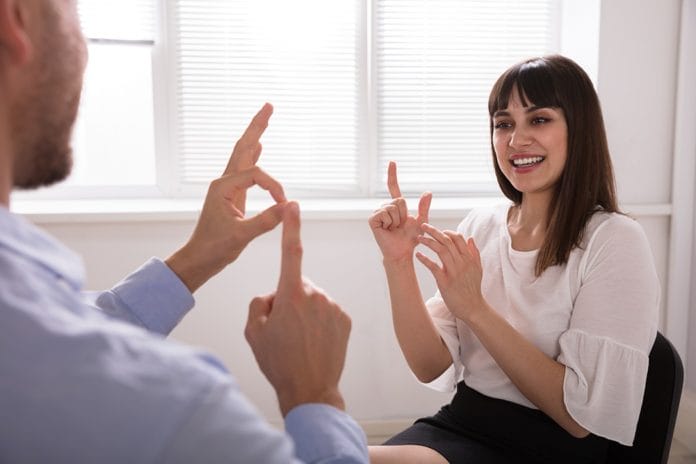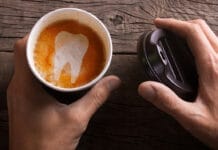The pandemic has placed more challenges on the deaf and hard-of-hearing community by making masks standard in most public places. A trip to the dental office can be scary for most people. For the deaf and hard-of-hearing community that relies on visual cues and lipreading for communication, it can be even more difficult.
Even mask-wearing in the dental operatory during this time has defeated the purpose of pulling down the mask for their lipreaders due to COVID-19 restrictions, even at a “social distance.” Prior to the pandemic, life was easy enough to accommodate lowering the mask briefly.
Patient care is our number one priority in the dental office. We want our patients to feel comfortable in the chair, and clear communication is a key component to achieving this. The masks that we are required to wear directly affect communication with this community. The masks keep us safe, but, if you’re someone who doesn’t know American Sign Language, they can cause individuals with hearing loss to shut down.
When we feel shut down, we’re unable to feel safe and comfortable. So, how do we plan to keep the dental community safe from COVID-19 but still be able to communicate with our deaf and hard-of-hearing patients?
There are many ways to be considerate of the deaf and hard-of-hearing population, including the following communication methods:
1) Let them know you are here for them
Show how you will accommodate their needs. Get on social media and state how you’re going to keep your team and patients safe while still being able to communicate − for example, check-in via text messaging, clear masks, face shields, and assistive technologies you are using for those with hearing loss. Plant it on your website. Send out a newsletter. This way, patients can feel good about coming in to see their dentist and, at the same time, will know your office is doing everything they can to make patients comfortable in the dental chair.
Another great suggestion is to use digital booking online and/or text messages notifying you of the updates in your patient portal. This way, the communication between the office and the patient isn’t an issue. Adding these features can greatly benefit patients and show that your office is inclusive.
2) Interpreter
Kindly ask if they need an interpreter ahead of time. The Americans With Disabilities Act requires you to provide an interpreter to a deaf or hard-of-hearing person at no charge. According to MT & Associates, “Sign language interpreters are required under HIPAA not to disclose a deaf or hard-of-hearing patient’s private information.”5 Most agencies will have HIPAA training provided for the interpreters.
If it’s only a regular, recall appointment, an interpreter may not be necessary unless they need treatment that involves a deeper understanding of what it entails. If multiple treatments are needed, you may want to schedule a meeting another day so they can plan for an interpreter present.
Some patients will bring their friends, family members, or a spouse to help them out as well. Please be open to family members joining them during their appointments. Make sure that everyone understands the patient’s confidentiality rights. What is discussed in the dental room will stay in the dental room. Also, the care provided is based on the patient’s decision and not the family member’s decision. While some offices may require a one-person only policy, some make an exception for their patient’s rights.
3) Pen and paper
This can be used for short exchanges. Writing down simple questions, such as “Chief complaints?” or “Changes in medical history?” can be very helpful. It’s also a great icebreaker at the start of appointments. You can always start by writing a small joke to get the patient smiling.
4) Visual aids
These are great for everyone, not just the deaf and hard-of-hearing! Using nonverbal pictures to show and explain treatments can be extremely helpful and informative. Things such as illustrative pamphlets, booklets, and even educational videos work very well as visual aids. If you’re using videos, just make sure the video has a closed caption option.
5) Clear masks
These are amazing pieces of personal protective equipment that have a clear window in the mask to enable reading lips. It’s great to have these on hand in case you have a patient that relies simply on facial expressions, lipreading, and/or visual cues.
These masks help break down communication barriers and help increase accessibility for different types of patients − not just for the deaf and hard-of-hearing. Young children in particular love to see their dental professional smiling.
6) Watch your body language
Speak carefully and don’t turn your back on the patient while talking. Talk directly and clear while looking at your patient. If an interpreter is present, do not talk directly to them − always talk directly to your patient.
Keep your words simple and brief. Also, do not try to talk super slow as if you’re trying too hard. It can be viewed as rude. Talk at a normal pace.
7) Use assistive technology
A great device to try is SpeakSee, and a great app to try is the HearBeHeard app. They are both incredible and can translate in real-time. The SpeakSee device allows multiple speakers such as a small conference meeting. HearBeHeard app is basically a pocket interpreter. It’s only $10 and it can be used on your phone. The app is currently available on Apple App Store and will soon be coming to Google Play.
Both technologies are super convenient and helpful, especially during this trying time. As for confidentiality, you can use a release form simply stating that you have explained what you’re using and why you’re using it, and then the patient can sign and date their consent. Remember, everyone is unique and may have a preference on how to communicate. Always ask and don’t assume.
8) Smile
Even if you must smile with your eyes, having a friendly presence and relationship with your patient is what keeps them coming back to see you. You are their advocate for oral health and being sensitive to their needs and fully accepting them is the goal. In the end, it is our duty to provide accessibility.
Originally published on and adapted from TeethTalkGirl.com
Now Listen to the Today’s RDH Dental Hygiene Podcast Below:
References
- Adata.org. 2018. Accessible Health Care | ADA National Network. [online] Available at: https://adata.org/ factsheet/accessible-health-care
- Hear / Be Heard. Retrieved from https://www.hearbeheard.com/
- Are Dentists Required to Provide Interpreters for Dental Visits and Other Dental-related Situations? Kentucky Board of Dentistry. Retrieved from https://dentistry.ky.gov/Documents/ADA.pdf
- Making Conversations Accessible. SpeakSee. Available at: https://www.speak-see.com/
- Sign Language Interpreters and HIPAA. 2016. Retrieved from https://www.mtapractice.com/2016/10/26/hipaa-sign-language-interpreters-medical/
- Questions and Answers for Healthcare Providers. National Association of The Deaf – NAD. Retrieved from https://www.nad.org/resources/health-care-and-mental-health-services/health-care-providers/questions-and-answers-for-health-care-providers/
- Weber, M. Deaf Patients in The Dental Office: How You Can Help. 2016. DMD Today. Retrieved from https://www.dmdtoday.com/news/deaf-patients-in-the-dental-office-how-you-can-help












